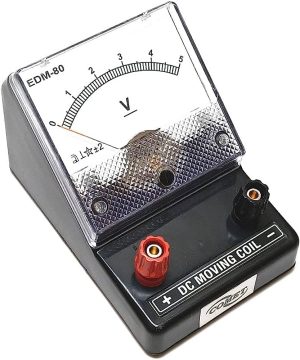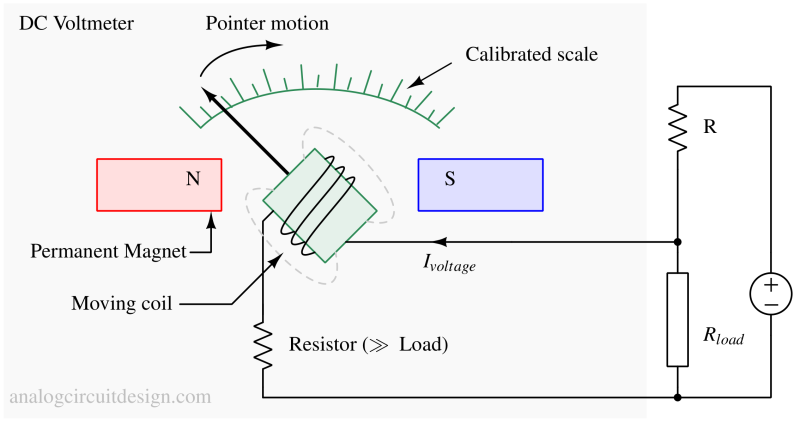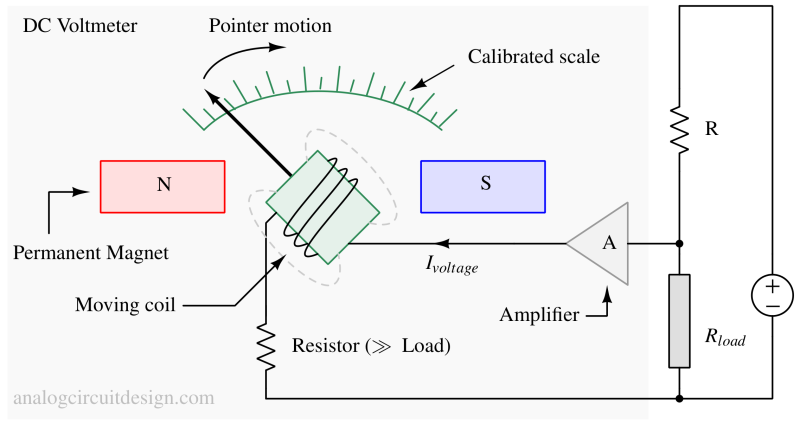Voltmeter
What is a Voltmeter?¶
A voltmeter is an electrical measuring instrument used to measure the voltage or potential difference between two points in an electrical circuit by connecting it in parallel. A real voltmeter has a very high resistance, drawing negligible current out of the measured circuit. It allows engineers to ensure proper operation, diagnose problems, and make informed decisions regarding electrical systems.

Voltmeters can be analog or digital. Analog voltmeters use a needle or pointer that moves along a scale to indicate the voltage reading. Digital voltmeters, on the other hand, display the voltage reading as a numerical value on a digital screen. Digital voltmeters often offer features like auto-ranging (automatic range selection) and higher precision.
Principle of voltmeter¶
When a voltmeter is connected across a circuit element, it forms a parallel branch with that element. This parallel branch creates a current path for a small current to flow through the voltmeter. The voltmeter then measures this current and, using Ohm's law, calculates the voltage across the circuit element.
The voltmeter uses an internal mechanism to convert the current passing through it into a corresponding voltage reading. In analog voltmeters, this is typically achieved using a galvanometer, a sensitive current-measuring device. The galvanometer's needle or pointer moves along a scale, indicating the voltage reading.
Types of Voltmeter¶
The types of voltmeter are listed below :
Analog DC voltmeter¶
An analog voltmeter is an electrical measuring instrument that measures the voltage or potential difference between two points in an electric circuit. It operates on the principle of using a moving coil in a magnetic field created by a permanent magnet to indicate the voltage value on a calibrated scale. This type of voltmeter is called Permanent Magnet Moving Coil (PMMC) voltmeter.

Here are the main components and working principles of an analog voltmeter (PMMC type):
Moving Coil: The heart of an analog voltmeter is a coil or piece of iron mounted on a spindle and can rotate. This coil is placed in a magnetic field generated by a pair of permanent magnets.
Scale and Pointer: An analog voltmeter has a circular or linear scale marked with voltage values. A pointer, attached to the moving coil or iron, moves across the scale to indicate the current through the high-value resistor. This current is proportional to the voltage across the load. Springs provide a restoring force to the moving coil or iron and keep it in equilibrium. A damping mechanism, such as an air vane or fluid-filled chamber, prevents the pointer from oscillating excessively and settling quickly.
Deflecting Torque: When a voltage is applied to the voltmeter, it generates a current through the coil or iron. This current interacts with the magnetic field, creating a deflecting torque that causes the coil or iron to move. A high-value resistor limits the current.
Calibration: The scale on an analog voltmeter is calibrated to provide accurate voltage readings. Calibration takes care of the internal high value resistance, deflecting torque, range etc.
Analog voltmeters have several advantages: simplicity, reliability, and relatively low cost. However, they typically have limited accuracy and are susceptible to parallax errors, where the viewing angle affects the reading.
Amplified analog DC voltmeter¶
An amplified analog voltmeter, also known as an amplified voltmeter or an AC/DC voltmeter, is an analog voltmeter that incorporates an amplifier circuit to increase sensitivity and improve measurement accuracy. The amplifier is typically used to amplify the small voltage signals before it generates torque for the pointer to move. The amplifier can be made of a high-precision operational amplifier with high input impedance (which will not load the circuit under measurement) and very low offset voltage.

Amplified analog voltmeters offer several advantages over basic analog voltmeters, such as increased sensitivity, extended measurement range, and improved accuracy. By incorporating an amplifier, these voltmeters can measure lower voltage levels and are less affected by internal resistance and loading effects.
Moving iron type voltmeter¶
Moving Iron (MI) voltmeter is a device used to measure both AC and DC voltages. This device's deflection is directly proportional to the coil's voltage. It is further divided into Attraction Type Moving Iron Instruments and Repulsion Type Moving Iron Instruments.
Digital voltmeter¶
A digital voltmeter (DVM) is an electronic instrument used to measure voltage levels in electrical circuits. Unlike analog voltmeters, which use a moving pointer on a scale, digital voltmeters display the voltage value numerically on a digital screen. They offer higher accuracy, resolution, and ease of use than analog voltmeters.
Here are the key components and their functions inside a digital voltmeter:
Analog-to-Digital Converter (ADC): The input voltage is first converted from an analog signal to a digital representation using an ADC. The ADC samples the input voltage at regular intervals and quantizes it into discrete digital values.
Microcontroller or Digital Signal Processor (DSP): The digital values obtained from the ADC are processed by a microcontroller or DSP. These devices perform calculations and conversions to determine the voltage value and format it for display.
Display: The voltage measurement is shown on a digital display, typically an LCD (Liquid Crystal Display) or LED (Light-Emitting Diode) screen. The numerical value of the voltage is directly shown, often with units such as volts (V).
Range Selection: Digital voltmeters usually have multiple voltage ranges that can be selected to accommodate a wide range of voltage levels. The user can switch between ranges to ensure the most accurate measurement within the desired voltage range.
Accuracy and Resolution: Digital voltmeters are known for their high accuracy and resolution. Accuracy refers to how closely the displayed value matches the actual voltage, while resolution refers to the smallest voltage difference the instrument can detect and display.
Additional Features: Many digital voltmeters offer extra functionalities such as auto-ranging (automatic selection of the appropriate range), hold function (freezing the displayed value), peak voltage measurement, relative measurement mode, and integration with other test and measurement instruments.
Digital voltmeters are widely used in various applications, including electronics, electrical engineering, industrial settings, laboratories, and everyday household use. They provide quick and precise voltage measurements, making them a popular choice for professionals and hobbyists due to their convenience and accuracy. They have almost replaced all the analog voltmeters.